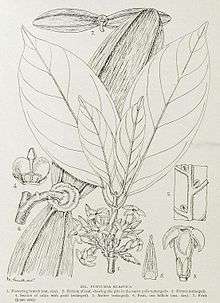Funtumia elastica
Funtumia elastica (also known as the bush rubber tree[1] or silkrubber[2]) is a medium-sized African rubber tree with glossy leaves, milky sap, and long woody seedpods. The bark is used in the traditional medicine of tropical Africa. It is economically important in West African countries such as Ghana, where it is commonly known as the ofruntum.[1]
| Silkrubber | |
|---|---|
 | |
| Scientific classification | |
| Kingdom: | Plantae |
| Clade: | Tracheophytes |
| Clade: | Angiosperms |
| Clade: | Eudicots |
| Clade: | Asterids |
| Order: | Gentianales |
| Family: | Apocynaceae |
| Genus: | Funtumia |
| Species: | F. elastica |
| Binomial name | |
| Funtumia elastica (Preuss) Stapf | |
Chemical constituents
A variety of chemical compounds have been identified in F. elastica. Unprocessed F. elastica powder is distinctly blue due to its anthocyanin content. The steroidal alkaloid conessine, which is found in F. elastica, has anti-bacterial properties in vitro.[3]
Bioactivities
Crude extracts of F. elastica inhibit growth of many molds, including Aspergillus, Penicillium, and Candida, as well as the fungi that cause ringworm.[4]
References
- Blench, Roger (2006). Archaeology, language, and the African past. Altamira Press. ISBN 9780759104655.
- Funtumia elastica at USDA PLANTS Database
- Bogne Kamga P, Penlap Beng V, Lontsi D, et al. Antibacterial activities of the extracts and conessine from Holarrhena floribunda. Afr J Trad Complem Alt Med. Vol. 4, No. 3, 2007, pp. 352-356.
- Adekunle AA, Ikumapayi AM. Antifungal property and phytochemical screening of the crude extracts of Funtumia elastica and Mallotus oppositifolius. West Indian Med J. 2006 Sep;55(4):219-23.